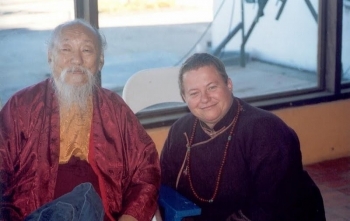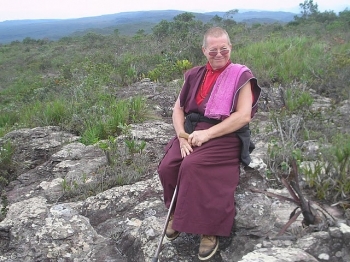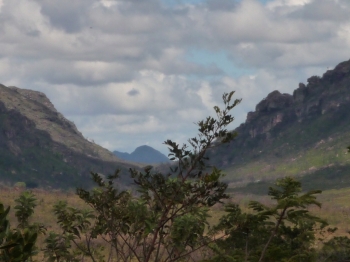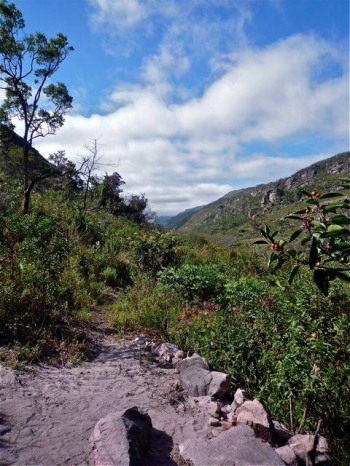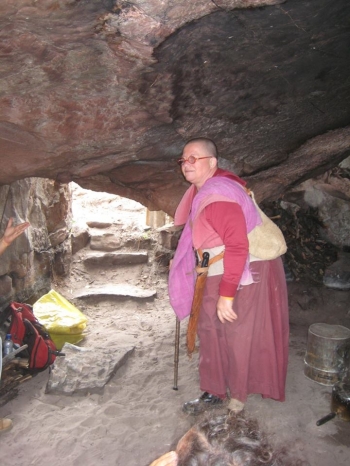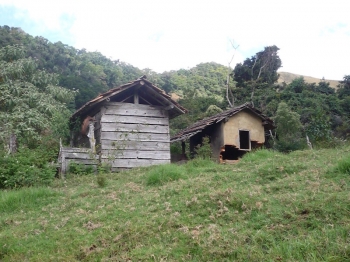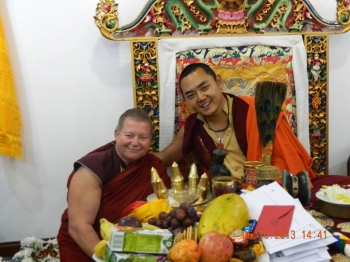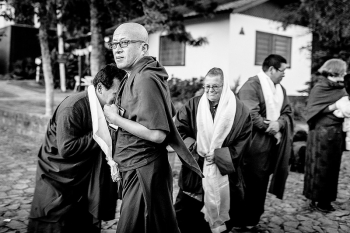Ani Zamba Chozom was one of the first Westerners to be ordained as a Buddhist nun. Born in England in 1948, a serious illness as a teenager aroused in her a strong desire to benefit others. In search of answers to her confusion about life, in the 1960s she traveled overland to India, and has since practiced in many different countries and traditions. Today she lives mainly in Brazil, where her practical teachings, rooted in the simplicity of Dzogchen, are proving an inspiration to Buddhists and non-Buddhists alike. On a recent visit to Hong Kong, Frances McDonald interviewed her about her fascinating life, which will be published here on Buddhistdoor in eight weekly parts.*
FM: At what point did Chagdud Rinpoche invite you to go to Brazil, where he had been living since the mid-1990s and where he had set up a number of centers and built a Tibetan-style temple, Khadro Ling?
AZ: After I left the retreat in Hong Kong, I called him in Brazil and said I was concerned that he was getting old and I was getting sicker, and before one of us died I really wanted to spend some time with him again. Originally I went there for a few months, and after I began to travel around, he felt I had a karmic connection with the northeast of Brazil. He asked if I was really ready to leave Asia, and invited me to be his representative for the northeast. I then came back to Hong Kong to get a religious visa that would allow me to stay there long-term and also to pack things up. I arrived back in Brazil on New Year’s Eve in 1999.
FM: Where did you start off?
AZ: I first based myself in the city of Maceio, where we managed to put together quite a large center. I also managed to set up about 11 groups and other centers around the northeast, from the Amazon Basin down to Rio. I stayed in Maceio for about three years, but did not particularly like living in the city and felt that possibly a project in a more rural area could be more expansive and benefit more people. After searching around, I came across a region in the interior of the state of Bahia called Chapada Diamantina National Park, which felt right, and some time later I received a telephone call from the community in the small town of Mucuge in the region saying they wanted to offer me some land in order to develop the project I envisioned for “human development.” This project was to be called Dipamkara's Vision, a name given by Dzongsar Khyentse Rinpoche.
FM: What happened to the project?
AZ: Though a wonderful aspiration, Dipamkara's Vision never really got off the ground as there weren’t enough funds to build the kind of infrastructure that might have been needed and there was no real interest from the community to help implement these ideas. Then later I was shown the valley of Monte Azul, which is 30 kilometers from Mucuge and which I thought would be ideal for a retreat center, and so I managed to acquire that 200 hectares of land as well. I decided to focus more on Monte Azul, and have led a number of retreats on the land. I also found a cave there, and spent the year 2012 in it doing solitary retreat.
FM: And now?
AZ: After spending almost ten years in that region, I now feel it is time to move to another state that might make it possible for more people to have access to a retreat environment. So recently I acquired a further 220 acres of land in the state of Minas Gerais in a place called Alagoa. Once again I will start from scratch, as there is nothing there except beautiful land. Still, already I feel there is much more interest from people in the surrounding region. The new center will be called Ati-ling, a name given by HH Dudjom Yangsi Rinpoche.
FM: In general, how have you found teaching in Brazil?
AZ: It’s hard to talk in general, but mostly I find the Brazilians very open, very receptive, quite playful, and very interested in Buddhism, though it takes time to introduce the value of these ideas enough to inspire people to want to integrate them into the way they see life. You know, it took 20 years from the time Chōgyam Trungpa first went to America for people’s minds to really mature enough to digest the teachings, for them to be able to integrate them into daily life. So in Brazil it will also take time.
FM: Have some people begun to take them on board?
AZ: Buddhism is something new in Brazil. Like mindfulness, it’s become fashionable, but to help people to see how it works in daily life, that’s the real test. I have some students in each group that are really practicing and integrating what they learn from their practice into their field of work. Quite a few of my students are doctors, psychotherapists, and physicists, and some have now developed courses around my teachings. They don’t actually say, “This is Buddhism,” but they use the teachings in integrated medicine, and they’re really working—they’re really benefiting a lot of people. For example, a lot of cancer programs are using my teachings to help work with the trauma of cancer. It’s really quite good to see how they’re working there.
FM: I guess you’re not of the school of belief that would say that mindfulness divorced from Buddhism is not good, or not useful—that because it’s not leading to enlightenment, it’s not what the Buddha intended.
AZ: I’d like to mention that the path does not depend on what you call yourself or how you identify yourself. We need to look at the motivation or the intention of the people who are
